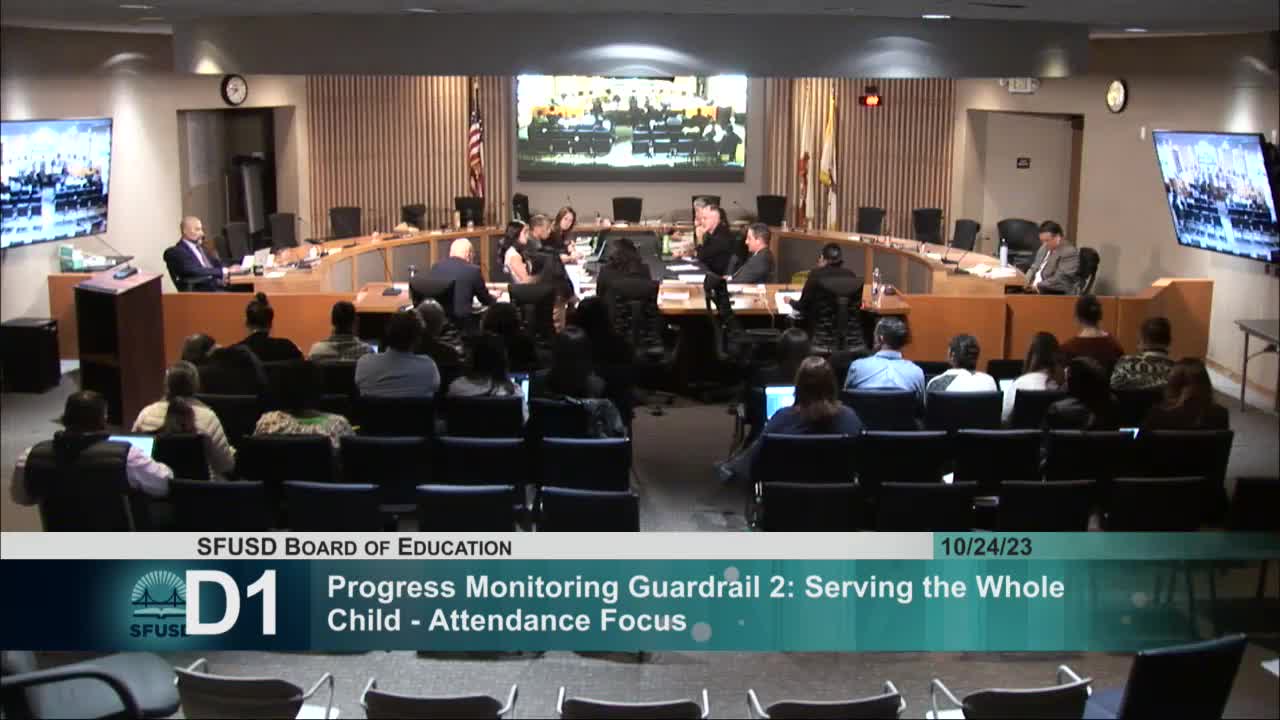SFUSD reports significant drop in missing attendance sections amid new strategies
October 24, 2023 | San Francisco City, San Francisco County, California
This article was created by AI summarizing key points discussed. AI makes mistakes, so for full details and context, please refer to the video of the full meeting. Please report any errors so we can fix them. Report an error »

In the heart of San Francisco's City Hall, a pivotal meeting unfolded, shedding light on the ongoing efforts to improve student attendance across the city's schools. As officials gathered, the atmosphere buzzed with optimism, particularly in light of recent data revealing a significant reduction in missing attendance sections. Last year, the city faced a staggering 3,000 missing sections; this year, that number has plummeted to just 1,000. This achievement, attributed to enhanced collaboration and updated attendance practices, marks a promising step forward for the San Francisco Unified School District (SFUSD).
John Holmes, who oversees attendance tracking, presented the latest findings, emphasizing the importance of addressing absenteeism. The newly published attendance manual, designed to equip school staff with effective strategies, has been instrumental in this progress. The focus on data-driven solutions reflects a broader commitment to ensuring that every child is accounted for and engaged in their education.
The meeting also highlighted the potential of Universal Pre-Kindergarten (UPK) as a means to foster early engagement in education. With over 400 early education providers in San Francisco, there is a concerted effort to create a seamless transition for families as their children move from early childhood care to formal schooling. This initiative aims to instill the importance of attendance from a young age, reinforcing the idea that consistent school participation is vital for academic success.
Commissioner Fisher, reflecting on past attendance initiatives, expressed excitement about the current momentum. She recalled a previous working group that engaged over 700 stakeholders, emphasizing the need for actionable change rather than mere discussions. The focus now is on creating a cohesive plan that centers on students and families, supported by robust data collection systems.
However, challenges remain. Discussions revealed concerns about the complexities of chronic absenteeism and the need for deeper analysis to understand its root causes. Some officials noted that inconsistencies in attendance data have hindered efforts to target support effectively. Additionally, principals voiced frustrations regarding students who leave the district without proper paperwork, inadvertently affecting their former schools' attendance records.
As the meeting progressed, the conversation shifted to the emotional landscape of students. A surprising drop in the sense of belonging among students was noted, raising questions about the effectiveness of current initiatives aimed at fostering community and connection within schools. This decline, particularly stark in the wake of the pandemic, underscores the need for ongoing efforts to ensure that students feel valued and supported in their educational journeys.
In conclusion, the meeting served as a reminder of the challenges and triumphs facing San Francisco's educational landscape. With a renewed focus on attendance and a commitment to understanding the underlying issues affecting students, officials are poised to make meaningful strides in enhancing the educational experience for all. As the city moves forward, the hope is that these efforts will not only improve attendance rates but also cultivate a sense of belonging that empowers every student to thrive.
John Holmes, who oversees attendance tracking, presented the latest findings, emphasizing the importance of addressing absenteeism. The newly published attendance manual, designed to equip school staff with effective strategies, has been instrumental in this progress. The focus on data-driven solutions reflects a broader commitment to ensuring that every child is accounted for and engaged in their education.
The meeting also highlighted the potential of Universal Pre-Kindergarten (UPK) as a means to foster early engagement in education. With over 400 early education providers in San Francisco, there is a concerted effort to create a seamless transition for families as their children move from early childhood care to formal schooling. This initiative aims to instill the importance of attendance from a young age, reinforcing the idea that consistent school participation is vital for academic success.
Commissioner Fisher, reflecting on past attendance initiatives, expressed excitement about the current momentum. She recalled a previous working group that engaged over 700 stakeholders, emphasizing the need for actionable change rather than mere discussions. The focus now is on creating a cohesive plan that centers on students and families, supported by robust data collection systems.
However, challenges remain. Discussions revealed concerns about the complexities of chronic absenteeism and the need for deeper analysis to understand its root causes. Some officials noted that inconsistencies in attendance data have hindered efforts to target support effectively. Additionally, principals voiced frustrations regarding students who leave the district without proper paperwork, inadvertently affecting their former schools' attendance records.
As the meeting progressed, the conversation shifted to the emotional landscape of students. A surprising drop in the sense of belonging among students was noted, raising questions about the effectiveness of current initiatives aimed at fostering community and connection within schools. This decline, particularly stark in the wake of the pandemic, underscores the need for ongoing efforts to ensure that students feel valued and supported in their educational journeys.
In conclusion, the meeting served as a reminder of the challenges and triumphs facing San Francisco's educational landscape. With a renewed focus on attendance and a commitment to understanding the underlying issues affecting students, officials are poised to make meaningful strides in enhancing the educational experience for all. As the city moves forward, the hope is that these efforts will not only improve attendance rates but also cultivate a sense of belonging that empowers every student to thrive.
View the Full Meeting & All Its Details
This article offers just a summary. Unlock complete video, transcripts, and insights as a Founder Member.
✓
Watch full, unedited meeting videos
✓
Search every word spoken in unlimited transcripts
✓
AI summaries & real-time alerts (all government levels)
✓
Permanent access to expanding government content
30-day money-back guarantee

